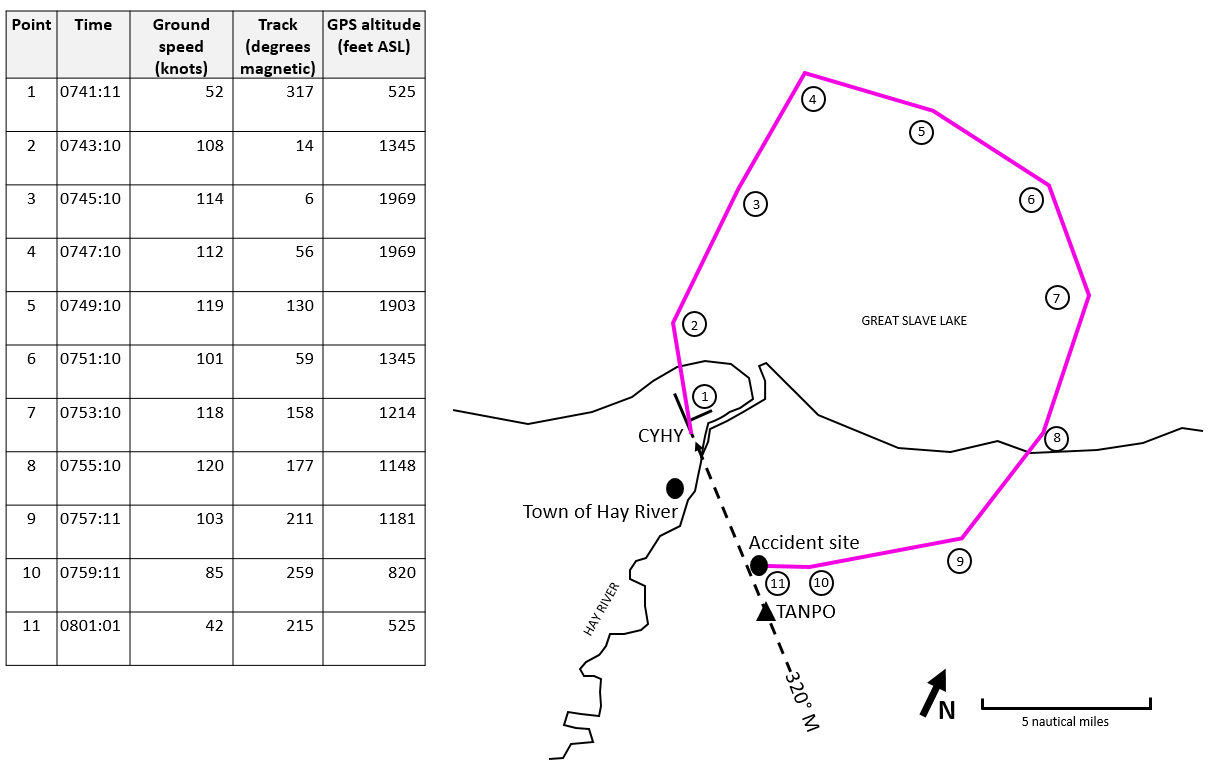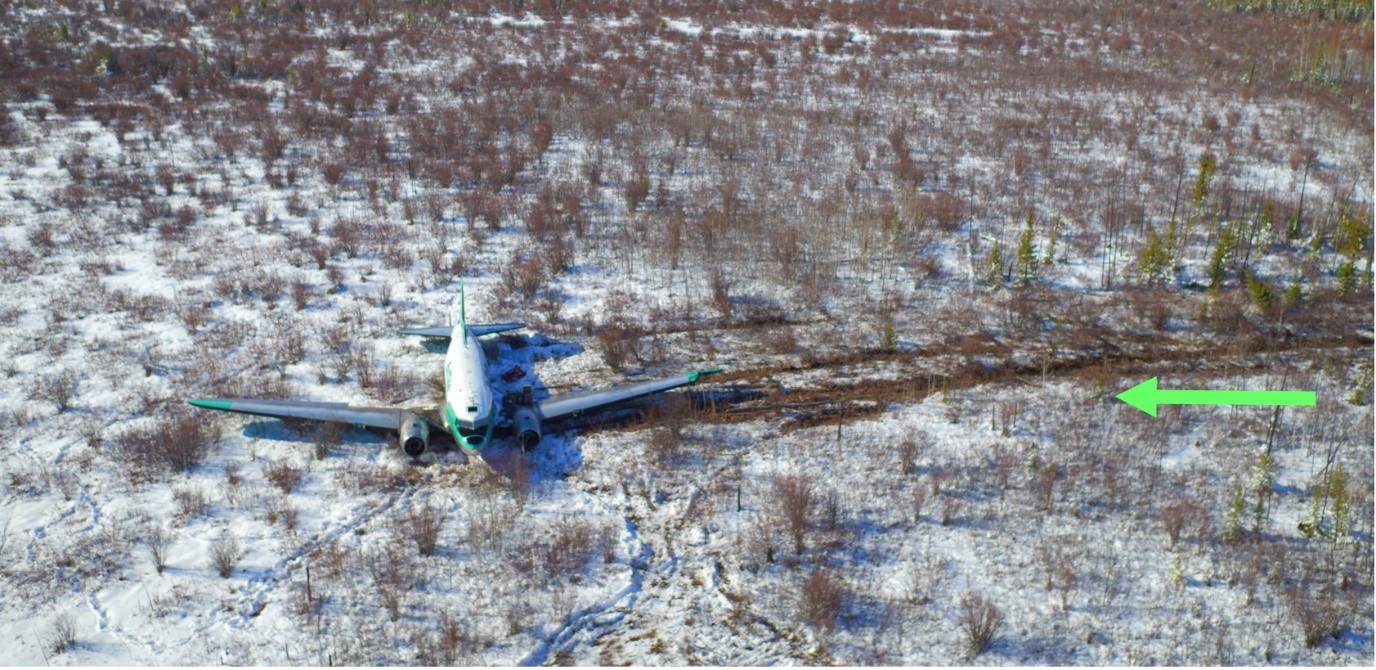Air transportation safety investigation report A19W0052
Engine power loss and forced landing
Buffalo Airways Ltd.
Douglas DC3C-S1C3G, C-GJKM
Hay River/Merlyn Carter Airport, Northwest Territories
The Transportation Safety Board of Canada (TSB) investigated this occurrence for the purpose of advancing transportation safety. It is not the function of the Board to assign fault or determine civil or criminal liability. This report is not created for use in the context of legal, disciplinary or other proceedings. See Ownership and use of content.
History of the flight
At 0741Footnote 1 on 03 May 2019, the Douglas DC3C-S1C3G (registration C-GJKM, serial number 13580), operated by Buffalo Airways Ltd. (Buffalo Airways), departed Hay River/Merlyn Carter Airport (CYHY), Northwest Territories, on an instrument flight rules flight for a scheduled cargo flight to Yellowknife Airport (CYZF), Northwest Territories, with 2 flight crew members on board. The captain was the pilot flying (PF) and the first officer (FO) was the pilot not flying (PNF).
Visibility at the time of departure was 4 statute miles (SM) in light snow. A few minutes later, the visibility decreased to 1½ SM in light snow, with a ceiling of 3500 feet above ground level.Footnote 2
After departure, while the aircraft was climbing through 1200 feet above sea level (ASL)Footnote 3 on the way to a cruising altitude of 5000 feet ASL, the flight crew completed the after-takeoff checklist and applied carburetor heat to 20 °C.
While the FO was applying the carburetor heat, oil pressure was observed decreasing on the left engine (Pratt & Whitney R-1830-92). Moments later, rising cylinder head temperature and oil temperature indications were also observed on the left engine. The captain directed the FO to contact the area control centre to declare a PAN PAN emergencyFootnote 4 and request a return to CYHY, which the FO then did. The aircraft flight manual (AFM) does not contain any procedures for abnormal engine indications.
The aircraft was equipped with a satellite tracking unit that reported the following information every 2 minutes:
- Average ground speed
- Average track
- Average global positioning system (GPS) altitude
Figure 1 shows the aircraft’s track based on the data retrieved from the satellite tracking unit.

As the aircraft reached an altitude of 1969 feet ASL (Figure 1, point 3), the captain set the left engine to a reduced power setting and increased the power on the right engine to maximum except takeoff (METO)Footnote 5 power. The flight crew began to set up for an instrument landing system approach to CYHY via TANPO.Footnote 6
At 0747 (Figure 1, point 4), while the aircraft was in a right turn proceeding towards TANPO, smoke and oil were observed, and abnormal sounds were heard coming from the left engine. Using the engine failure checklist, the flight crew then shut down the left engine and feathered the propeller. At 0748, because the situation had escalated, a MAYDAY emergencyFootnote 7 was declared. Moments later, the flight crew completed the descent checklist and initiated the approach checklist. However, due to the escalating emergency, the flight crew was not able to complete the approach checklist, which included the landing briefing.
At 0753 (Figure 1, point 7), the aircraft levelled off at 1214 feet ASL. The FO observed zero hydraulic pressure on the landing gear DOWN gauge.Footnote 8 Thinking this zero pressure was an issue, he mentioned it to the captain, who then directed the FO to “prep the gear.” The FO extended the landing gear, which the captain did not expect because the aircraft had not started its final approach and the airport had not been visually acquired.
At 0755 (Figure 1, point 8), as the aircraft continued towards TANPO, the altitude was between 1200 and 1300 feet ASL, and the airspeed was maintained at approximately 100 knots indicated airspeed (KIAS). When the aircraft was abeam TANPO, the captain began a right turn to intercept the localizer for the final approach. The aircraft’s airspeed decreased from 100 KIAS to 80 KIAS, while its altitude decreased to 1100 feet ASL. With the reduced airspeed, the aircraft’s flight control response became sluggish and the captain directed the landing gear to be raised (Figure 1, point 9).
After the landing gear was raised, at 0759, the flight crew heard abnormal sounds and felt vibrations from the right engine. The aircraft’s airspeed was 80 KIAS, and its altitude began to decrease to below 800 feet ASL.
In an attempt to maintain altitude, the right engine was increased to maximum takeoff power, but this had no effect. The flight crew then prepared for an emergency gear-up landing, and the aircraft’s flaps were lowered on short final to reduce speed for touchdown.
At 0801, the aircraft landed in muskeg on K’atl’Odeeche First Nation land, approximately 3.5 nautical miles southeast of CYHY. After the aircraft came to a stop, the FO exited the aircraft through the right-hand crew window, while the captain remained in the cockpit to secure the right engine and aircraft systems before evacuating via the forward door. The FO contacted the flight information centre to notify them of the crew’s status and aircraft location. The emergency locator transmitter had not activated during the forced landing, so the FO activated it manually to assist search and rescue in locating the aircraft. The flight crew was uninjured. The aircraft received substantial damage (Figure 2). There was no post-impact fire. First responders arrived at the accident site at 1114.

Personnel information
Records indicate that the captain and FO were certified and qualified for the flight in accordance with existing regulations.
The captain held an airline transport pilot licence - aeroplane and a valid Category 1 medical certificate at the time of the occurrence. He had accumulated over 9400 hours total flight time, including 300 hours on type.
The FO held a commercial pilot licence - aeroplane and a valid Category 1 medical certificate at the time of the occurrence. He had accumulated over 900 hours total flight time, including 400 hours on type.
Based on a review of the captain and the FO’s work-rest schedules, fatigue was not considered a factor in the occurrence.
Aircraft information
The aircraft was certified, equipped, and maintained in accordance with existing regulations and approved procedures. The weight and balance were within the prescribed limits. The aircraft was not equipped with a flight data recorder or cockpit voice recorder, nor were these required by regulation.
Due to the limited scope of this investigation, the cause of the oil discharge leading to the left engine being shut down was not determined. Similarly, the source of the abnormal sounds the flight crew reported hearing from the right engine was not identified.
Standard operating procedures and checklists
Buffalo Airways has developed normal and emergency checklists to use when operating the company’s Douglas DC3C-S1C3G aircraft.
Items related to the landing gear are included in various checks on the normal checklist, including the following:
AFTER TAKE-OFF CHECKS
GEAR & FLAPS………………………….UP & NEUTRAL
[…]
PRE-LANDING CHECKS
GEAR…………………………………………UP THEN DOWN
[…]
GEAR…………………………………………DOWN, PRESSURE UP, GREEN LIGHT, POSITIVE LOCKFootnote 9
Buffalo Airways’ standard operating procedures (SOPs) expand on the normal checklist items by describing challenge and response drills. Relevant gear-related standard calls are set out in Table 1.
| Phase of flight | Condition | Pilot flying | Pilot not flying |
|---|---|---|---|
| Take-Off & Climb | Airborne, Positive Rate of Climb | “Positive Rate, Gear Up” | “Gear in Transit”, then “Gear up” |
| Descent and Approach | 1 Dot Above Glideslope | “1 Dot Above, Gear Down” “Landing Checks”, “Flaps ¼” | “Check, Gear Down Selected”, “Gear Down, Pressure UP, Green Light”, “Flaps set ¼” (Complete Pre-Landing Checklist), “Pre-Landing Checks Complete” |
The emergency checklist includes challenge and response drills that require immediate action, some of which are to be completed from memory. The drills to be completed from memory are indicated by a box around the items on the checklist. The engine failure emergency checklist includes the following item related to the landing gear:
ENGINE FAILURE
POWER ON LIVE ENGINE
[…]
LANDING GEAR………………………UPFootnote 10
The AFM contains single-engine landing procedures that require the landing gear to be lowered when the aircraft is on final approach and at a safe altitude.Footnote 11 The Buffalo Airways emergency checklist procedure for approach with 1 engine inoperative is consistent with the AFM requirement, and states:
APPROACH WITH ONE ENGINE INOPERATIVE
LANDING GEAR…………………(ON FINAL AT SAFE ALTITUDE) DOWN […]Footnote 12
The Buffalo Airways SOPs for an engine-out landing include the following instructions:
- Prior to extending the landing gear, be sure all other hydraulic systems are off.
- Extend the Landing Gear at such a point that the drag will not cause undershooting.
- (about 25 seconds are required to extend the landing gear) […]Footnote 13
Single-engine performance
The AFM states the following with respect to single-engine performance:
- Minimum Airspeed: With one engine inoperative and METO power or less on the operating engine, the minimum airspeed for controllability is 73 knots IAS [KIAS]. With take-off power, minimum IAS [indicated airspeed] for controllability is 76 knots. Control of the aircraft will be easier if it is flown with 2 - 3° bank on the operating engine side. […]
- Single Engine Climb: The rate of climb of the DC-3, with the landing gear down and full flap, is practically zero. With the landing gear up and 1/2 flap, the rate of climb is very low, therefore, during climbing operation on a single engine the flaps and landing gear should be fully retracted. […]
- Cruise: Up to METO power may be used for cruise with one engine out. Air speed depends on gross weight, and should be maintained at 110 knots at 26,000 lbs., and at 105 knots at 24,000 and below.Footnote 14
This aircraft departed with a weight of 26 000 pounds.
Crew resource management
Buffalo Airways has a Transport Canada–certified crew resource management training program,Footnote 15 which includes information on effective communication. Both flight crew members received this training. The captain completed the training on 01 May 2019, and the FO on 28 December 2018.
The preamble to the Buffalo Airways SOPs states that “[s]tandard phraseology must be used to reduce the likelihood of an incorrect interpretation of a request or command and to initiate corrective action for undesirable circumstances.”Footnote 16
In Chapter 10, the SOPs indicate that “[e]mergency operating procedures are designed to follow, as close as possible, to [sic] normal operating procedures so as to reduce any confusion brought on by an abnormal occurrence.” The SOPs go on to say that “during an emergency situation, the PF will continue flying the aircraft and call for the appropriate actions and checklist. Which [sic] will be called or read out by the PNF.”Footnote 17
With regard to standard phraseology, Chapter 10 of the SOPs states the following:
During abnormal/emergency situations it is imperative that the flight crew not only understand and complete the applicable procedures, but also ensure that effective communication is maintained. The standardization of calls and actions removes the unexpected and enhances communication.Footnote 18
Safety message
In this occurrence, the aircraft’s airspeed and altitude could not be maintained, primarily because of the increased drag when the landing gear was extended early in the approach. This highlights the need to follow SOPs and use standard phraseology, as well as the importance of checklist discipline, during an emergency.
This report concludes the Transportation Safety Board of Canada’s investigation into this occurrence. The Board authorized the release of this report on . It was officially released on .
This report is the result of an investigation into a class 4 occurrence. See the Policy on Occurrence Classification.